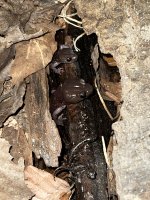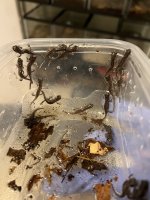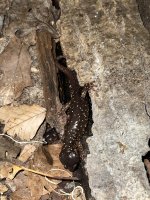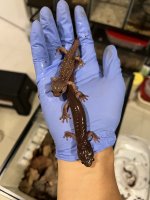Dumbodo
New member
I am thrilled to offer offsprings from my beautiful pair of aneides lugubris. This is my second year breeding them, act fast if you are interested!
Some care info:
I keep all my salamanders in my basement in New York, where the summer temperature averages around 71°F and drops to 55°F in the winter. Humidity ranges from about 85% in the summer to 60% in the winter. My adult pair lives in a 10-gallon tank, with ¾ of the lid covered in plastic wrap during the warmer months to maintain higher humidity. In the colder months, I remove the wrap to expose half of the lid. I mist the tank twice a week in summer and twice a month in winter. The substrate is a mix of coconut fiber, pine chips, leaf litter, twigs, and sphagnum moss, filling nearly half the tank. A thick layer of oak leaves is spread on top, and I use oak bark from my backyard as hides, stacking the pieces to create varying humidity levels. Their diet includes mostly dusted crickets, with occasional waxworms, houseflies, and earthworms.
This year, the eggs hatched around late August
I kept the babies in the same enclosure as the adults for them to exchange beneficial bacteria(Thanks Tim Herman). I feed them dusted melanogaster fruit flies 3 times a week. The babies have grown quite a bit since hatching and they should be ready to take 1/4 crickets in another month or so. In one of the photos, you can see one of last year's juveniles with the mother in the middle and this year's baby on the bottom.
I am offering the babies $125 each plus shipping, you can contact me at [email protected] or text 9177898488 for a faster reply. Thank You!
Some care info:
I keep all my salamanders in my basement in New York, where the summer temperature averages around 71°F and drops to 55°F in the winter. Humidity ranges from about 85% in the summer to 60% in the winter. My adult pair lives in a 10-gallon tank, with ¾ of the lid covered in plastic wrap during the warmer months to maintain higher humidity. In the colder months, I remove the wrap to expose half of the lid. I mist the tank twice a week in summer and twice a month in winter. The substrate is a mix of coconut fiber, pine chips, leaf litter, twigs, and sphagnum moss, filling nearly half the tank. A thick layer of oak leaves is spread on top, and I use oak bark from my backyard as hides, stacking the pieces to create varying humidity levels. Their diet includes mostly dusted crickets, with occasional waxworms, houseflies, and earthworms.
This year, the eggs hatched around late August
I kept the babies in the same enclosure as the adults for them to exchange beneficial bacteria(Thanks Tim Herman). I feed them dusted melanogaster fruit flies 3 times a week. The babies have grown quite a bit since hatching and they should be ready to take 1/4 crickets in another month or so. In one of the photos, you can see one of last year's juveniles with the mother in the middle and this year's baby on the bottom.
I am offering the babies $125 each plus shipping, you can contact me at [email protected] or text 9177898488 for a faster reply. Thank You!





